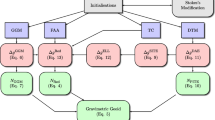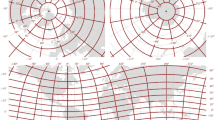Abstract
A technique for renormalization of integral equations is used for obtaining very robust solutions. The number of multiplications used for inverting the integral equations can be reduced dramatically and mostly only weighted means will be needed. Theoretical gain in computer time might be up to 100 000 times for the most favourable cases when using 1000 unknowns. (Practical gains will be considerably less.) Solutions have been obtained with increased accuracy compared to the classical technique over integral equations. Surface elements might be of arbitrary size but the method is optimal for a global approach with equal area elements. The solutions were found strictly invariant with respect to the depth to the internal sphere, when using simpler models.
Applications in surveying are possible after some modifications.
Renormalization of integral equation has been widely used in the theory of quantum field.
Similar content being viewed by others
References
A. BJERHAMMAR: Gravity Reduction to a Spherical Surface of Reference. Technical Report, Div. Geodesy, Royal Institute of Technology, Stockholm, 1962.
A. BJERHAMMAR: A New Theory of Geodetic Gravity. Trans. Royal Institute of Technology, No. 243, Stockholm, 1964.
A. BJERHAMMAR: Linear Prediction and Filtering, Festschrift Karl Ledersteger, Osterr. Ver. Verm. Wse., Wien, 1970.
A. BJERHAMMAR: Discrete Approaches to the Solution of the Boundary Value Problem in Physical Geodesy. Erice, 1974. (Boll. d. Geodesia e Scienze Affini, 34, No. 2, pp. 185–240, 1975.)
A. BJERHAMMAR: Dirac Approach to Physical Geodesy. ZfV 101, pp. 41–44, 1976.
A. BJERHAMMAR and Leif SVENSSON: The convergence of harmonic reduction to an internal sphere. Bull. Géod. No. 3, pp. 247–257, 1979.
J. BOSSLER: Megatrends in geodesy. AGU, NOAA Rockville (in press), 1984.
J. DENY: Systemes totaux des fonctions harmoniques. Ann. de l'Institut Fourier, 1949.
A.S. GOLDERGER: Best Linear Unbiased Prediction in Generalized Linear Regression Models. Journal of the American Statistical Association 57, pp. 369–375, 1962.
P. HOLOTA: The Altimetry-Gravity Boundary Value Problem. Intercosmos, Bulgaria Albena, 1980.
L. HÖRMANDER: The Boundary Value Problem of Physical Geodesy. Arch. Rat. Mech. Anal., 62, pp. 1–52, 1976.
R.L. INGRAHAM: Renormalization. Theory of Quantum Field. Theory of Cut-Off. Gorder and Breach. City of Publisher, 1980.
K.E. KATSAMBALOS: Comparison of Some Undulation Prediction Techniques from Altimeter Data. Report No. 303, Dept. of Geodetic Science, Ohio State University, Columbus, 1980.
K.E. KATSAMBALOS: Simulation Studies of the Computation of the Gravity Vector in Space from Surface Data Considering the Topography of the Earth. Ohio State University, Dept. of Geodetic Science Rep. 314, Columbus, 1981.
M. KELDYCH and M. LAVRENTIEFF: Sur les Suites Convergentes de Polynomes Harmoniques. Travaux Inst. Math. Tbilissi, pp. 165–184, T.l. 1937.
T. KRARUP: A Contribution to the Mathematical Foundations of Physical Geodesy. Geod. Inst. Medd., 44, Copenhagen, 1969.
D.L. LAURITZEN: Methods in Physical Geodesy. Geodetisk Institut, Copenhagen 1973.
H. MORITZ: Advanced Least Squares Methods. Report Dept. Geodetic Science, No. 175, Ohio State University, Columbus, 1972.
H. MORITZ: Least Squares Collocation. Rev. Geoph. Space Phys., 16:3, pp. 421–430, 1978.
R.H. RAPP: The Formation and Analysis of a 5°×5° Equal Area Block Terrestrial Gravity Field. Ohio State University, Dept. of Geodetic Science Rep. No. 178, Columbus, 1972.
U. RAUHALA: A Review of Array Algebra. DBA Systems INC, Florida, 1976.
H. SÜNKEL: A General Surface Representation Module Designed for Geodesy. Report No. 292, Department of Geodetic Science, Ohio State University, Columbus, 1980.
H. SÜNKEL: Cardinal Interpolation. Report No. 312, Department of Geodetic Science, The Ohio State University, Columbus, 1981.
L. SVENSSON: A new geodesy based upon inversion free Bjerhammar predictors. Eighth symposium on mathematical geodesy. Como 1981. Published Firenze 1983.
C.C. TSCHERNING and R.H. RAPP: Closed Covariance Expressions for Gravity Anomalies, Geoid Undulations, and Deflections of the Vertical Implied by Anomaly Degree Variance Models. Ohio State University, Dept. of Geodetic Science Rep. 208, Columbus, 1974.
C.C. TSCHERNING: On the Use and Abuse of Molodensky's Mountain. In: Geodesy in Transition. Ed. K.P. Schwarz and G. Lachapelle. Surveying Engineering Publication 60002, 1983.
J.L. WALSH: The Approximation of Harmonic Functions by Harmonic Polynomials and by Harmonic Rational Functions. Bull. Am. Math. Soc. 35, pp. 499–544, 1929.
Author information
Authors and Affiliations
Rights and permissions
About this article
Cite this article
Bjerhammar, A. A robust approach to global problems in physical geodesy. Bull. Geodesique 59, 303–315 (1985). https://doi.org/10.1007/BF02521065
Received:
Accepted:
Issue Date:
DOI: https://doi.org/10.1007/BF02521065




